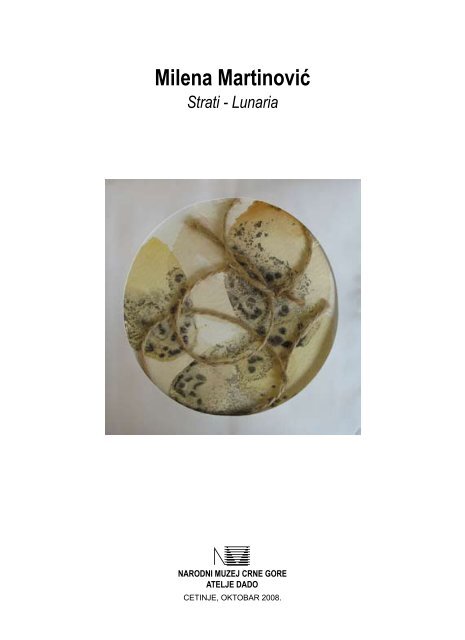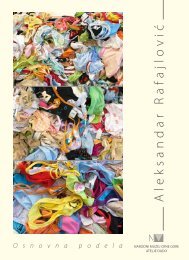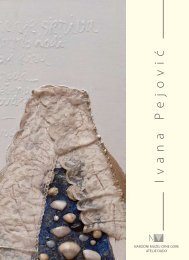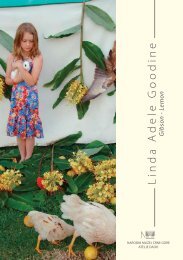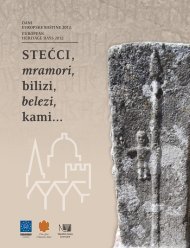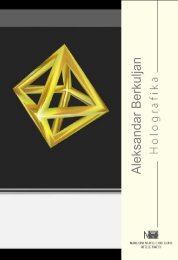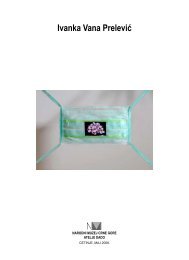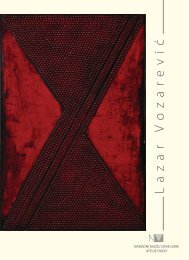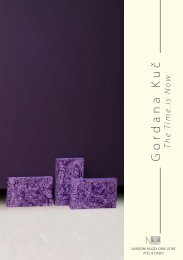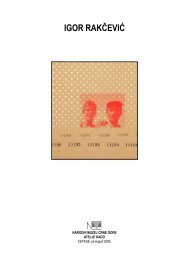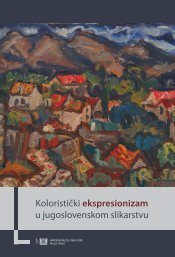Milena MartinoviÄ - Narodni muzej Crne Gore
Milena MartinoviÄ - Narodni muzej Crne Gore
Milena MartinoviÄ - Narodni muzej Crne Gore
Create successful ePaper yourself
Turn your PDF publications into a flip-book with our unique Google optimized e-Paper software.
<strong>Milena</strong> Martinović<br />
Strati - Lunaria<br />
NARODNI MUZEJ CRNE GORE<br />
ATELJE DADO<br />
CETINJE, OKTOBAR 2008.
«« ”Na temu kopiranja”<br />
kombinovana tehnika 12,5 cm x 12,5 cm<br />
Spirala / Spiral, 2008.
“Kada mu pogledate crteže, oni liče na mape, što je čudno za jednog vajara. Te konture ne daju oblike,<br />
one jednostavno označavaju granice koje se mogu preći. U svim njegovim delima reč je o odlascima.<br />
Ponajviše o napuštanju zemlje i odlasku na nebo, što njegovi Stubovi - bez - kraja, navodno, i čine.”<br />
- Džon Berdžer o Konstantinu Brankusiju.<br />
Sličan utisak izlaska iz okvira realnog prostora može se steći posmatrajući radove Milene Martinović.<br />
Dugotrajan proces pročišćavanja i svođenja ideje na jednostavan oblik, materijalizovan je na platnima<br />
u vidu konture, okvira koji nagovještava formu. U preispitivanju odnosa prema sebi i spoznaji o procesu<br />
stvaralačkog čina ona poseže za sjećanjima iz djetinjstva, prizivajući davno potisnute emocije i najranija<br />
stečena iskustva. Tražeći jednostavan način na koji bi se najbolje materijalizovala potreba za jednom<br />
transformabilnom, neutralnom, gotovo nevidljivom, a opet višeznačnom strukturom ona pronalazi<br />
konkretnan oblik u prirodi - list Lunarie. Ova biljka specifičnog elipsastog oblika, polu prozirnog, skoro<br />
nestvarnog sedefastog sjaja postaje uzor za razvijanje kreativnog djelovanja. Prateći promjene u njenom<br />
životnom ciklusu - sušenje, ljuštenje, truljenje, ispadanje sjemena, ponovno klijanje... ona posredno<br />
sagledava vlastite mjene, preispitujući smisao postojanja doživljen u širem kontekstu, i svoje mjesto na<br />
kosmičkoj mapi, viđeno kroz čin stvaranja.<br />
Gradeći jedan “poseban lični svijet”, u kojem ovaj list predstavlja jezgro, a ne samo omot, ona stvara hermetični<br />
mikrokosmos, samo njoj spoznatljiv, koji funkcioniše po principima prirode, prilagođavajući se iskonskom ritmu<br />
nastajanja i nestajanja, nastojeći pritom da sačuva autentičnost sopstvenog umjetničkog jezika.<br />
Odabrani motiv varira, prilagođavajući ga tehnici i materijalu - na crtežima je vidljivo mnoštvo slojeva,<br />
prepletenih, gustih nanosa; slike nose snagu zamaha - veličina elipsi je proporcionalno uvećana shodno<br />
formatu, dok se na instalaciji najsnažnije osjeća začudna energija prozračnog, lakog, krhkog lista.<br />
Prilagođavajući način građenja spletova ona varira njihovu gustinu, ali oblik uvjek ostaje isti. Ponekad su<br />
neki djelovi elipse dodatno potencirani, stvarajući tako novi sloj - kompaktnu mrežu koja štiti tanke strukture<br />
ovalnih formi. Često gradirani pastelnim tonovima, ili nijansama jedne boje djelovi koji se preklapaju,<br />
pojačavanjem kontura grade nove skupove, snažne unutrašnje međuprostore. Upravo ovaj konkretan<br />
oblik, eliminisanjem primarnog značenja, dobija na važnosti, postaje prilagodljiva pojavnost, jednako<br />
snažan bilo kao znak, forma ili materijal. “Umjetnost je poseban vid našeg svakodnevnog bavljenja<br />
pojavnošću, u kojem prepoznajemo sebe i sve što nas okružuje.” - Gerhard Rihter.<br />
Tretman materijala je sasvim drugačiji na instalaciji. Ona poštuje prirodnu logiku materije, stvarajući<br />
jednu osobenu vrstu mobilne skulpture, lagane pokretne spirale sačinjene od osušenih listova biljke<br />
filigranski precizno fiksiranih jedan uz drugi. Ponovo se nameće asocijacija na beskonačni Brankusijev<br />
stub, koji iako ograničene visine, emanira enegriju kao da se njegov završetak ne nazire. Njena monuentalnost<br />
postaje metafora je za apsolutno. Krećući se od statičnosti koja bi se od jedne tako masivne forme<br />
mogla očekivati ka potpunoj dinamičnosti oblika zbog laganih elemenata, ona emanira pokret, latentnu<br />
tenziju, a priziva osjećanje koje Robert Smitson naziva “metafiziča arheologija”, energija tla. U njoj nema<br />
epicentra, niti središta radnje, ona djeluje kao istrgnuti dio jednog beskrajnog lanca, jedne tajne, skrivene<br />
DNK, unutrašnje strukture o kojoj se zna, ali koja se ne vidi. Taj zapis, magični “genetski kod” posredno<br />
može biti shvaćen kao hermetični kôd same umjetnice. Forma je spoznatljiva, oblik je stvaran ali iako<br />
vidljiva sjemena ispod opne lista nisu laka za dokučiti.<br />
Upravo je takav i sam Milenin kôd - na prvi pogled jasan i jednostavan, a opet posve skriven i hermetičan.<br />
A ovo može biti shvaćeno kao pokušaj da se odgonetne.<br />
Mirjana Dabović Pejović
“When you look at his drawings, they look like maps, which is unusual for a sculptor. These contours do<br />
not make shapes; they simply mark borders you can cross. All these works are about leaving. Mostly<br />
about leaving the earth and going to the sky, which his Columns-without-end, do.” John Berger on Constantin<br />
Brancusi<br />
A similar feeling of abandonment of the real space can be observed in the works of <strong>Milena</strong> Martinovic.<br />
The long process of reducing an idea to a simple shape is realized on paper as a contour, a frame that implies<br />
form. In questioning these relations toward herself and perceiving the process of creative moment,<br />
she reaches for memories from her childhood, recalling suppressed emotions and earliest experiences.<br />
Looking for a simple way in which to materialize something transient, neutral or almost invisible and yet<br />
more complex structure, she has found a concrete shape in nature, in the leaf of the plant Lunaria. Specific<br />
elliptical form, translucent, almost nacreous, has become the model for developing this creative act.<br />
Following the changes in the plant’s life cycles (withering, seeding, decomposing and growing again),<br />
<strong>Milena</strong> indirectly reconsiders her own changes, by questioning the meaning of her own existence in a<br />
wider context, and her place on a cosmic map, seen through the act of creation.<br />
Constructing a “specific personal world” in which this leaf represents the nucleus, and not just the padding,<br />
<strong>Milena</strong> creates hermetic microcosm, known only to her, whose function is based on the principles<br />
of nature, adapting to its iconic rhythms of becoming and disappearing, while trying at the same time to<br />
maintain the authenticity of personal artistic language.<br />
The chosen motive has variations, and has been adapted to the technique and materials; in some drawings<br />
there are many visible layers, overlapping and peaking through, in others with the force of a pendulum,<br />
the size of the ellipse is proportionally magnified, depending on the format, while the installation<br />
contains the strongest feeling of energy in the translucent light of a fragile leaf. Modulating the methods<br />
of building concatenations the thickness also varies, but the shape remains always the same. Sometimes,<br />
some parts of the ellipses are additionally emphasized, creating new layer and compact web that<br />
protects the thin structures of the oval shapes. Often, graduated pastels or halftone-hues colour parts<br />
overlap, amplifying the contours and creating new assemblages with strong inner spaces. Exactly this<br />
concrete shape by eliminating its primary meaning, gains the importance, and becomes flexible as appearance,<br />
equally strong as a sign, a form or material.<br />
“Art is particular way in our daily practice of manifestation in which we recognize ourselves and all that<br />
surround us” - Gerhard Richter.<br />
The treatment of material is completely different when used in the installation. <strong>Milena</strong> respects the natural<br />
logic of the substance, creating a distinctive kind of mobile sculpture, very light, mobile spiral made<br />
from dried leaves fixed in such a precise way as if they were made by an filigree. We come again to<br />
Brancusi’s endless column, which although limited in height emanates energy as if it had no end. Its monumentality<br />
becomes the metaphor for the absolute. Moving from the static, which could be expected from<br />
such a massive form, towards the absolute dynamics of shapes due to the light elements, it emanates<br />
the motion, latent tension, recalling the feeling that Robert Smithson’s calls “metaphysical archaeology”,<br />
energy of the ground. There is no epicenter, nor center of the action, it looks like it has been torn off from<br />
an endless chain, a secret DNA, we know resides within this structure, but we cannot see. That inscription,<br />
a magical “genetic code” can directly relate to the artists’ personal code. The form is recognizable,<br />
the shape is real but although visible the seeds under the membrane are not easy to be reached.<br />
Just the same is <strong>Milena</strong>s’ code - at first sight explicit and simple, but again quite hidden and hermetic.<br />
And all this can be understood as an attempt to decipher it.<br />
Mirjana Dabović Pejović
Garderober / Wardrobe, 2006.<br />
tuš na japanskom papiru / ink on Japanese paper
Čisto / Clean, 2006.<br />
kombinovana tehnika<br />
<strong>Milena</strong> Martinović<br />
rođena je 1980. na Cetinju, Crna Gora<br />
2004. - diplomirala je na Fakultetu Likovnih umjetnosti, Odjek vajarstvo<br />
2005. - studijski boravila u Pont Aven School of Contemporary Art, Francuska<br />
2008. - magistrirala na FLU Cetinje, Odsjek vajarstvo<br />
2008. - samostalno izlagala u Pont Avenu, Francuska, CIAC 2008.<br />
Učestvovala na više kolektivnih izložbi u zemlji i inostranstvu.<br />
Živi i stvara na Cetinju i u Dablinu, Irska<br />
born in 1980. in Cetinje, Montenegro<br />
2004. - graduated from the Faculty of Fine Arts in Cetinje, Department of sculpture<br />
2005. - specialization for one semester in Pont Aven School of Contemporary Art, France<br />
2008. - MA from the Faculty of Fine Arts in Cetinje, Department of sculpture<br />
2008. - Gallery CIAC Pont Aven, France (solo exhibition)<br />
Living and working in Cetinje and Dublin, Ireland.<br />
contact: milena.martinovic@gmail.com<br />
Izdavač: <strong>Narodni</strong> <strong>muzej</strong> <strong>Crne</strong> <strong>Gore</strong> | Fotografije: Lazar Pejović i <strong>Milena</strong> Martinović | Dizajn: After BK<br />
Štampa: DPC | Tiraž: 300 | Cetinje, 2008.


